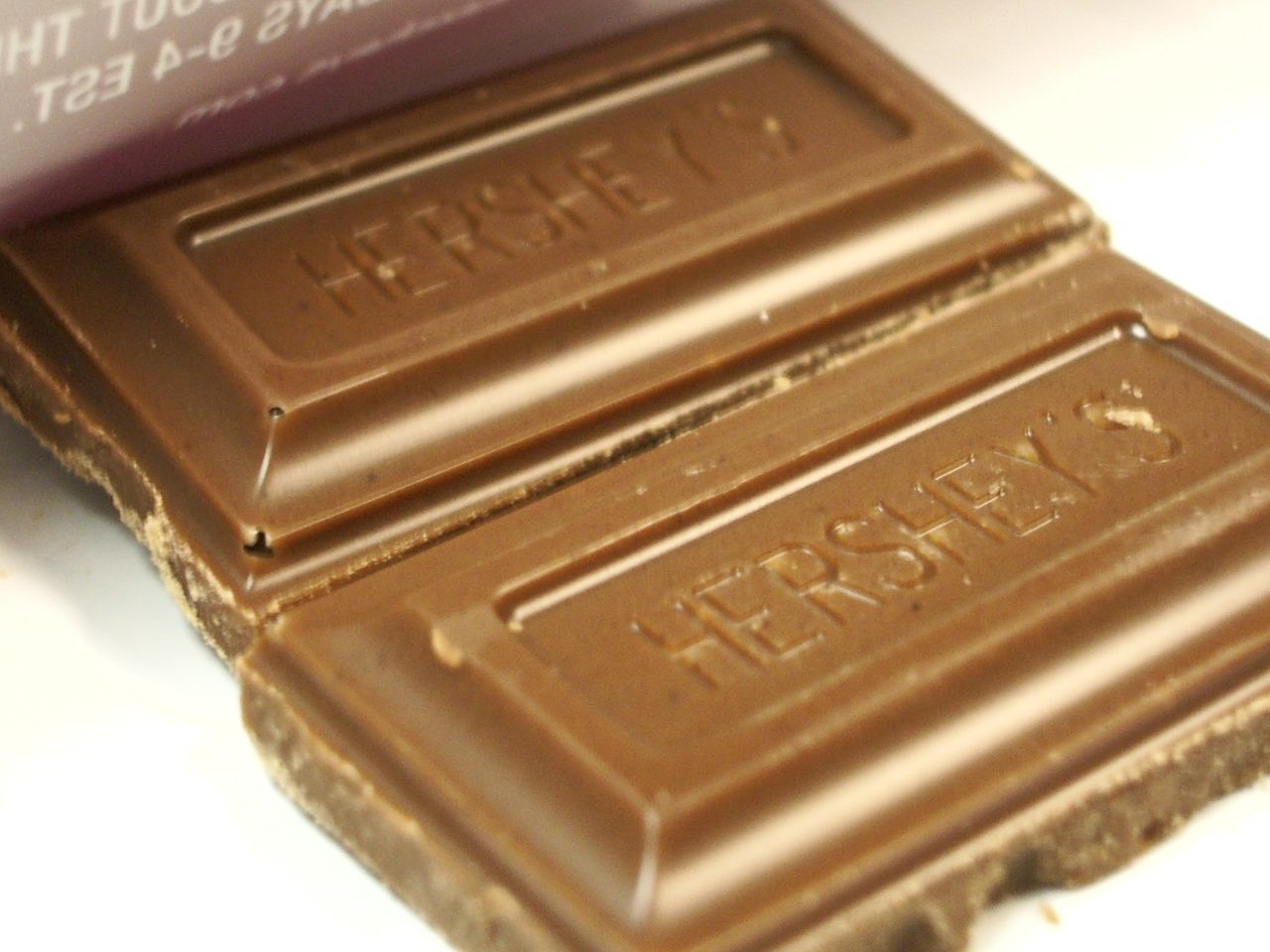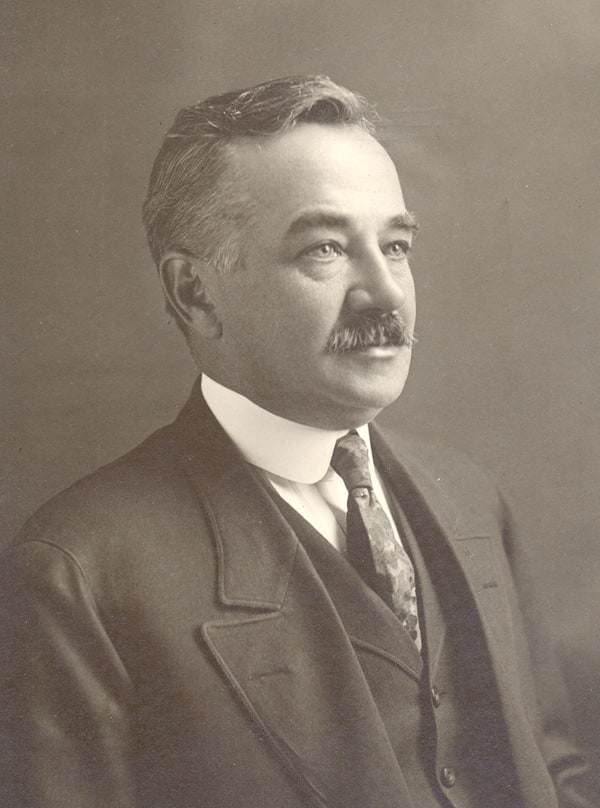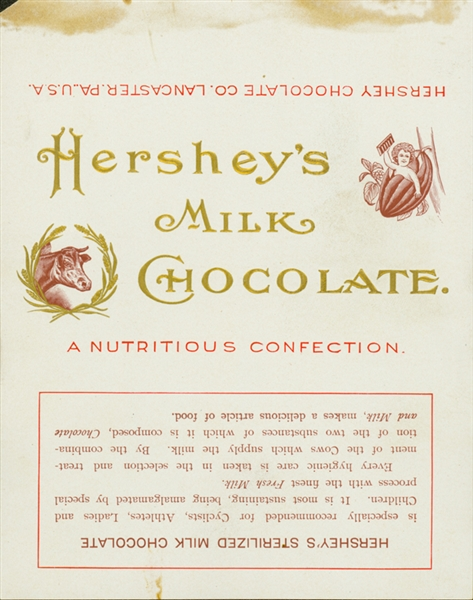1. Overview
Milton Snavely Hershey (1857-1945) was a pioneering American chocolatier, businessman, and philanthropist. Trained in the confectionery trade, he first achieved significant success with the Lancaster Caramel Company, which he later sold for 1.00 M USD to finance his ambitious venture into mass-produced milk chocolate. This led to the establishment of The Hershey Company, which introduced iconic products such as the Hershey bar and Hershey's Kisses. Hershey's vision extended beyond his factory, leading to the creation of Hershey, Pennsylvania, a meticulously planned company town designed to provide a high quality of life for his employees. His profound philanthropic legacy is most notably embodied in the Milton Hershey School, a boarding school originally founded for orphans, to which he eventually transferred the majority of his wealth and company control. Throughout his life, Hershey demonstrated a commitment to both innovative business practices and social welfare, leaving an enduring impact on American industry and philanthropy.
2. Early Life and Education
Milton Hershey's early life was marked by frequent relocations and a limited formal education, yet it laid the foundation for his future entrepreneurial spirit.
2.1. Childhood and Family Background
Milton Snavely Hershey was born on September 13, 1857, on a farm near Derry Church, Pennsylvania, as the only son of Henry and Veronica "Fanny" (née Snavely) Hershey. His family, of Swiss and German descent, were members of Pennsylvania's Mennonite community, and he grew up speaking Pennsylvania Dutch. Like many rural youths of his time, Hershey spent his early years assisting with farm chores and agricultural work, which instilled in him the value of labor and perseverance. His father, Henry Hershey, was prone to moving frequently and pursuing various unsuccessful business ventures, which caused the family's income to be unstable and led to Milton's disrupted schooling and constant travel. Milton's younger sister, Sarena Hershey, was born in April 1862 and tragically died at the age of four in 1867.
2.2. Education and Early Apprenticeships
Due to his family's frequent moves and his father's fluctuating business endeavors, Milton Hershey received a very limited formal education, completing only the fourth grade. In 1871, he left school at the age of 14 and began an apprenticeship with Sam Ernst, a local printer who published a German-English newspaper in Lancaster, Pennsylvania. Hershey found the printing work tedious and, after an incident where he accidentally dropped his hat into a machine, causing it to break, he was fired. Although his father pleaded for a second chance, his mother and aunt, Mattie Snavely, believed he would be better suited to the candy-making trade.
Through his mother's arrangement, the 14-year-old Hershey was apprenticed to Joseph Royer, a confectioner in Lancaster. He trained under Royer for four years, acquiring foundational skills in the candy-making craft. In 1876, at the age of 19, Hershey moved to Philadelphia to start his first confectionery business, borrowing money from relatives. He sold hard candies and caramels from a pushcart for six years, but this venture ultimately failed due to disagreements with his father. Milton then traveled extensively, seeking opportunities in Denver, Colorado, New Orleans, and Chicago. In Denver, he learned the technique of making caramels using fresh milk, a skill that would prove crucial to his later success. He eventually settled in New York City in 1883, where he trained at Huyler's, a prominent confectionery company. He opened his second business there, which initially thrived but closed after only three years in 1886.
3. Business Career
Milton Hershey's business career was characterized by perseverance, innovation, and a keen understanding of market opportunities, culminating in the creation of a confectionery empire.
3.1. Lancaster Caramel Company
After his second business failed, Hershey returned to Lancaster, Pennsylvania, in 1883. With a loan from a bank and capital primarily from his mother's Mennonite family, he founded the Lancaster Caramel Company. Utilizing the caramel formulas he had learned during his travels, particularly the fresh milk technique from Denver, his company quickly gained renown for its high-quality caramels. His strategy of selling caramels in bulk proved highly successful. A significant turning point came when a British visitor to Lancaster tasted Hershey's candies and placed a large order for export to England. This enabled Hershey to repay his bank debts and invest in new ingredients and equipment, further expanding his operations.
By the early 1890s, the Lancaster Caramel Company had grown into a substantial enterprise, employing over 1,300 workers across two factories. In 1893, Hershey visited the World's Columbian Exposition in Chicago, where he was captivated by a German-made chocolate-making machine. This experience sparked his interest in chocolate, leading him to consider a new venture. After much deliberation, Hershey decided to take a calculated risk: he sold the highly successful Lancaster Caramel Company for 1.00 M USD in 1900 to fully dedicate himself to the burgeoning chocolate industry, believing it held greater promise than caramels.
3.2. Hershey Chocolate Company
Using the substantial proceeds from the sale of the Lancaster Caramel Company, Milton Hershey acquired approximately 62 mile2 (160 km2) of farmland near his birthplace in Derry Township, Dauphin County, Pennsylvania, located approximately 30 mile (31 mile (50 km)) northwest of Lancaster. This location was strategically chosen for its abundant supply of fresh milk, a critical ingredient for his ambitious goal: to mass-produce milk chocolate. At the time, milk chocolate was considered a luxury good, primarily imported from Switzerland. Hershey was determined to develop his own unique formula for milk chocolate that would appeal to the American public. After numerous trials and errors, he perfected his recipe.
The first Hershey bar was produced and sold in 1900. Its popularity quickly grew, leading to the development of Hershey's Kisses in 1907, followed by the Hershey's Bar with almonds in 1908. On March 2, 1903, Hershey began construction on what would become one of the world's largest chocolate factories. Completed in 1905, the factory was equipped with the latest mass production techniques, enabling Hershey's milk chocolate to become the first nationally marketed brand of its kind in the United States. The factory's central location amidst dairy farms allowed for a consistent supply of fresh milk, a key factor in the quality and scale of his chocolate production.
3.3. Founding of the Company Town of Hershey
Milton Hershey's vision extended beyond merely building a factory; he aimed to create a complete, self-sustaining community around it for his employees. He disliked the typical factory towns characterized by rows of simple houses and instead envisioned a place with comfortable housing, affordable transportation, quality schools, and ample recreational and cultural opportunities. He wanted a town with tree-lined streets and sturdy brick homes, each with its own yard.
This planned community, which eventually became known as Hershey, Pennsylvania, accreted around the factory with Hershey's direct support. He provided houses, businesses, churches, and a robust transportation infrastructure. Recreation was considered vital for employee well-being, leading to the development of amenities like Hersheypark, which opened on April 24, 1907. The park rapidly expanded to include amusement rides, a swimming pool, and a dance hall, attracting visitors from beyond the town. Hershey's commitment to creating a high quality of life for his workers was central to his philosophy, believing that a good environment would inspire better work.
4. Philanthropy and Social Vision
Milton Hershey's philanthropic endeavors were as significant as his business achievements, driven by a deep commitment to education and community welfare.
4.1. Milton Hershey School
Milton Hershey and his wife, Catherine, who were childless, decided to dedicate their wealth to helping others. In 1909, they established the Hershey Industrial School through a Deed of Trust. The school was originally intended to provide education and care for orphaned boys. In 1918, Hershey transferred the majority of his personal assets, including the controlling interest in The Hershey Company, to the Milton Hershey School Trust fund. This strategic move ensured that the school would have a perpetual source of funding and that the trust would maintain a majority of voting shares in the Hershey Company, allowing it to retain control of the business. In 1951, the school was officially renamed the Milton Hershey School. As of 2016, it accommodated approximately 2,000 students, continuing its mission to provide comprehensive care and education for children in need. The Milton Hershey School Trust also holds 100% control of Hershey Entertainment and Resorts Company, which owns properties such as the Hotel Hershey and Hersheypark.
4.2. Hershey Trust Company and Foundations
The establishment of the Hershey Trust Company was a pivotal step in securing Milton Hershey's philanthropic legacy. This entity was created to manage his vast assets and ensure the long-term financial stability of the Milton Hershey School. Beyond the school, Hershey also founded the M.S. Hershey Foundation in 1935. This private charitable foundation was dedicated to providing educational and cultural opportunities specifically for the residents of Hershey. The foundation provides funding for several key institutions within the community, including the Hershey Museum, Hershey Gardens, the Hershey Theatre, and the Hershey Community Archives.
4.3. Support for Community and Culture
Hershey's commitment to his community manifested in the development of numerous amenities and institutions. In 1923, he established the Hershey Cemetery on Laudermilch Road in Hershey, Pennsylvania, transferring the land for a symbolic 1 USD. A significant contribution to public health and education was the founding of the Penn State Milton S. Hershey Medical Center in 1963. This occurred when the board of the Milton Hershey School Trust, invoking the cy-près doctrine (a legal principle meaning "as close as possible"), made a gift of 50.00 M USD to the people of Pennsylvania. The only restriction was that the hospital had to be built in Hershey. The medical center functions as a teaching hospital and has an annual budget that far exceeds its initial construction cost.
4.4. Management Style and Labor Relations
Milton Hershey's approach to employee welfare was distinctive for his era. He held a strong belief that providing excellent living conditions for his workers would result in superior performance. He was passionately dedicated to nurturing the community within the company town of Hershey, creating a model environment complete with comfortable housing and various facilities. This reflected a paternalistic management style, where Hershey, as the benevolent capitalist, largely governed the town without a market or self-governing body, essentially acting as an "enlightened monarch."
However, this benevolent paternalism had its limitations. In 1937, workers, organized by the Congress of Industrial Organizations (CIO), demanded the right to form a union, standard working hours comparable to other chocolate factories, and explicit wage and allowance details in their employment contracts. Hershey, genuinely perplexed as to why his well-treated employees would make such demands, refused. A strike ensued, with 600 workers occupying the factory. This led to violent clashes when a majority of non-striking workers, loyal to Hershey, attempted to suppress the striking employees. Hershey, reportedly terrified, retreated to his mansion and left all negotiations to his lawyers. Although the initial unionization attempt failed due to the opposition of the majority of workers who sided with management, the long-term trend towards unionization was unstoppable. Hershey's workers eventually joined the Bakery, Confectionery, Tobacco Workers and Grain Millers' International Union, affiliated with the more moderate American Federation of Labor (AFL).
5. Personal Life
Milton Hershey's personal life, though marked by devotion and a lack of biological children, profoundly influenced his philanthropic endeavors.
5.1. Marriage and Family
On May 25, 1898, Milton Hershey married Catherine Elizabeth "Kitty" Sweeney. Kitty, born in 1872, was an Irish-American Catholic from Jamestown, New York. Hershey had met her while delivering caramels to a candy store in New York. All available evidence suggests their marriage was a happy one. The couple did not have any children, a fact that deeply impacted their decision to establish the Hershey Industrial School to help other children. Catherine suffered from an unknown, chronic illness for several years before her death on March 25, 1915. Hershey never remarried after her passing. In 1919, he had Catherine's body moved from Philadelphia to the Hershey Cemetery, which he had built. His mother, Fanny Hershey, died in March 1920 and was also buried there. In late 1930, his father's body was moved to the same cemetery.
5.2. Later Life
In 1944, Milton Hershey stepped down from the day-to-day management of his company, dedicating his final years to overseeing his philanthropic trust and the Milton Hershey School. He took great pride in the development of the school, the town, and the company, always prioritizing product quality and employee welfare over sheer profit.
6. Significant Events and Contributions
Beyond his core business and philanthropy, Milton Hershey's life was touched by notable events and his company made significant contributions during wartime.
6.1. Close Call with the Titanic
In 1912, Milton and Catherine Hershey had booked passage for the maiden voyage of the British luxury liner RMS Titanic. However, they canceled their reservations at the last minute due to pressing business matters requiring Hershey's attention. The cancellation is often mistakenly attributed to Kitty Hershey falling ill, but she had been chronically ill for several years by that point. Instead, they booked passage to New York on the German luxury liner SS Amerika. A copy of the check Milton Hershey wrote to the White Star Line as a deposit for a first-class stateroom on the Titanic was once displayed at the former Hershey Museum and is now preserved in the archives of The Hershey Story Museum, which replaced the original museum in 2009.
6.2. World War II Contributions
During World War II, The Hershey Chocolate Company played a crucial role in supplying specialized chocolate bars to the U.S. Armed Forces. These included the Ration D Bar and the Tropical Chocolate Bar. The U.S. Army had very specific requirements for the Ration D Bar: it had to weigh between 1 oz and 2 oz, resist melting at temperatures higher than 90 °F, and possess a sufficiently unpleasant flavor to deter troops from consuming it as a regular snack, thus preserving it for emergencies.
After one to two years, the Army was impressed by the durability and success of the Ration D Bar and commissioned Hershey to produce the Tropical Chocolate Bar. The Tropical Chocolate Bar was designed to taste better than the Ration D Bar while maintaining its durability and resistance to melting in tropical climates. It is estimated that between 1940 and 1945, over three billion Ration D and Tropical Chocolate Bars were produced and distributed to soldiers worldwide. In 1939, the Hershey plant was capable of producing 100,000 military chocolate bars per day. By the end of World War II, the entire Hershey plant was producing these ration bars at an astonishing rate of 2.4 million per week. For its exceptional service and for exceeding expectations in quality and quantity, The Hershey Chocolate Company was awarded five Army-Navy 'E' Production Awards. Furthermore, the Hershey factory machine shop even manufactured parts for tanks and other military machinery during the war effort.

7. Death
Milton Snavely Hershey died of pneumonia in Hershey Hospital on October 13, 1945, at the age of 88. He is buried in the Hershey Cemetery, which he himself established, on Laudermilch Road in Hershey, Pennsylvania. His grave is located in Section Spec-Her, Lot 1, Grave 1, adjacent to his wife's grave (Grave 2).
8. Legacy and Recognition
Milton Hershey's legacy extends far beyond his confectionery empire, encompassing a profound impact on education, community development, and philanthropy that continues to inspire.
8.1. Enduring Impact and Inspiration
At the Milton Hershey School, a bronze statue of Milton Hershey depicts him embracing an orphan boy, symbolizing his dedication to the children he served. Inscribed below the statue are the words: "His deeds are his monument. His life is our inspiration." This sentiment encapsulates the lasting influence of Hershey's work and his philanthropic vision. His commitment to providing opportunities for disadvantaged children, coupled with his innovative business practices, has left an indelible mark on American society. The company and the town he built stand as enduring testaments to his entrepreneurial spirit and social conscience.
8.2. Commemorative Honors
Milton Hershey's contributions have been recognized through various honors and commemorations. His birthday, September 13, is celebrated as one of several competing dates for International Chocolate Day. On September 13, 1995, the United States Postal Service issued a 32-cent stamp in his honor as part of the Great Americans series, recognizing him as a prominent philanthropist. The stamp was designed by Dennis Lyall, an artist from Norwalk, Connecticut. Hershey was also inducted into the Labor Hall of Fame, acknowledging his significant, albeit complex, impact on labor and industry. Institutions such as The Hershey Story Museum continue to preserve and share his life's work and legacy.

